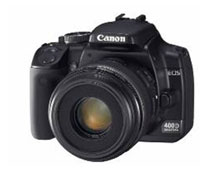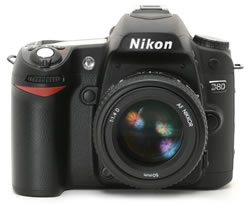People ask me all the time "Which camera should I buy?", by which they are normally referring to a point and shoot digital compact.
Over the summer there have been new compacts announced by pretty much all of the major manufacturers, so here's a summary of some of the best and a quick feature comparison.
I hasten to add, I haven't used any of these cameras, so make sure you read some proper reviews before making any purchasing decisions!
I've selected the newest, most comparable offerings from each manufacturer, so these are really the high-end of the ultra-compacts with the latest features, not your budget cameras.
So, here they are, in alphabetical order:
Canon Digital IXUS 850 IS
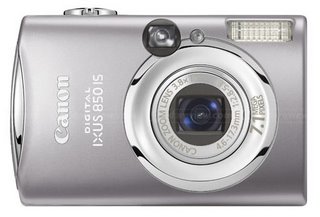
- 7.1 megapixels
- 2.5" LCD
- 25.1mm thick
- 640 x 480 @ 30 / 15fps movie mode
- ISO 1600
- 3.8x optical zoom
- Face Detection / 9-point focus
- SD / SDHC / MMC memory cards
- Optical image stabilisation
- Approx. 270 shots on one charge
Casio EXILIM Card EX S-770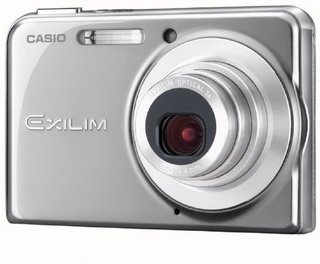
- 7.2 megapixels
- 2.8" widescreen LCD
- 17.3mm thick
- 704 x 384 (Wide), 640 x 480 movie mode
- ISO 800 (Anti Shake or High Sensitivity modes)
- 3x optical zoom
- 9 point multi focus
- SD / SDHC / MMC memory cards
- Anti-shake DSP
- Approx. 200 shots on one charge
Nikon Coolpix S7c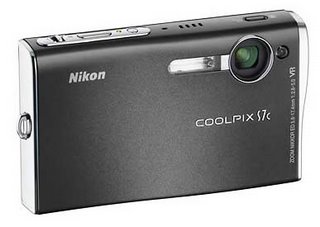
- 7.1 megapixels
- 3.0" LCD
- 21mm thick
- 640 x 480 @ 30fps movie mode
- ISO 1600
- 3x optical zoom
- Face-priority AF focus
- SD memory cards
- Vibration Reduction
- WiFi connection
- Approx. 200 shots on one charge
Pentax Optio S7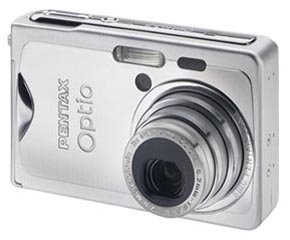
- 7.0 megapixels
- 2.5" LCD
- 19.5mm thick
- 640 x 480 @ 30 fps (DiVX) movie mode
- ISO 400 (800/1600 at 4 MP)
- 3x optical zoom
- 5-point multi focus
- SD / SDHC / MMC memory cards
- Blur reduction mode
- Approx. 180 shots on one charge
Sony CyberShot DSC-T10
- 7.2 megapixels
- 2.5" LCD
- 20.6 thick
- 640 x 480 @ 30fps movie mode
- ISO 1000
- 3x optical zoom
- 5-point multi focus
- Memory Stick Duo™ / Memory Stick Duo™ Pro memory cards
- Optical image stabilisation
- Approx. 250 shots on one charge
Comparison table(click image for large, readable version!)

So, all of the cameras have about the same resolution sensors; similar sized, decently large screens; similar movie modes and at least some kind of anti-shake or blur reduction.
I think table shows that spec-wise the Canon is the leader with it's high ISO 1600 sensitivity, optical image stabilisation, 3.8x zoom, face detection auto-focus and 270 shots on one charge. However, it does sacrifice on it's size and weight and is the most chunky of the 5.
The smallest is the Casio at just 17mm thick, nearly 8mm thinner than the Canon, while still managing to pack a 2.8" 16:9 display (the only widescreen display amongst this bunch), a 3x zoom, the same resolution and good battery life. It also has a widescreen movie recording mode. Very impressive and if having the most ultra-compact camera is what you're after, this is the one.
The Nikon has the largest screen at 3" and is the only camera here with WiFi for transferring images to your computer or printer wirelessly (although that may be frustratingly slow when downloading a whole memory card). It also has the same high ISO 1600 sensitivity and face recognition auto-focus as the Canon but it is also the second thickest after the Canon and doesn't support the new SDHC memory card format.
The Pentax doesn't really best any of the others in any category but it isn't too far off in most areas. It's the second thinnest after the Casio but it has the worst battery life at only 180 shots and only manages 4 megapixels at it's high sensitivity setting (7 megapixels normally). Otherwise, it's pretty much in line with the others with the 2.5" LCD, 3x zoom and 640 x 480 30fps movie mode.
Finally, the Sony is similar to the Pentax but slightly thicker, it does though have the second best battery life and is the only one here, other than the Canon, to have proper optical image stabilisation. But one of my pet hates about Sony is their insistence on using their own memory card format. All the other cameras here use SD but the Sony uses Memory Stick Duo, so if you already have SD cards, you're going to have to buy all new Memory Stick Duo cards to use the Sony.
So, which one would I buy? In the absence of hands-on reviews, judging purely on the specs and what I know of previous cameras from these manufacturers, I would say if you don't mind the extra bit of bulk, the Canon will probably take the best pictures but if smaller is better, then the Casio could well be the one. I would also consider the Nikon as it's possibly the best all round compromise between features and size.
I
definitely recommend you try and find some decent reviews of these cameras before buying one though and as always, go into Jessops or something, have a look and try them out as well.
dpreview.com is always a good place to find excellent reviews.
Tags:
cameras,
canon,
casio,
nikon,
pentax,
sony,
digital,
review,
roundup,
tech,
technology,
gadget,
schmadget,
scb
 In November I replaced my Sony DSC-P10 digital camera with a very nice Canon IXUS 850IS. This was quite a big step for me - to move away from Sony, I debated whether I should get a newer Sony and took quite a bit of convincing against it - but at the end of the day, I was replacing my Sony because it had failed, not because it was out-dated. The Canon had excellent reviews, was comparable in every way and I have not looked back since.
In November I replaced my Sony DSC-P10 digital camera with a very nice Canon IXUS 850IS. This was quite a big step for me - to move away from Sony, I debated whether I should get a newer Sony and took quite a bit of convincing against it - but at the end of the day, I was replacing my Sony because it had failed, not because it was out-dated. The Canon had excellent reviews, was comparable in every way and I have not looked back since.





